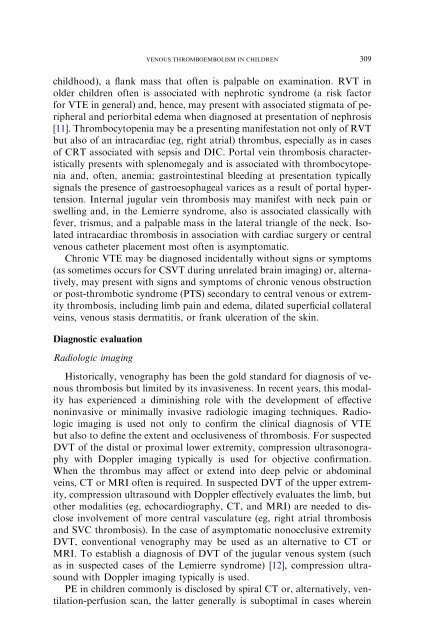Pediatric Clinics of North America - CIPERJ
Pediatric Clinics of North America - CIPERJ
Pediatric Clinics of North America - CIPERJ
You also want an ePaper? Increase the reach of your titles
YUMPU automatically turns print PDFs into web optimized ePapers that Google loves.
VENOUS THROMBOEMBOLISM IN CHILDREN<br />
309<br />
childhood), a flank mass that <strong>of</strong>ten is palpable on examination. RVT in<br />
older children <strong>of</strong>ten is associated with nephrotic syndrome (a risk factor<br />
for VTE in general) and, hence, may present with associated stigmata <strong>of</strong> peripheral<br />
and periorbital edema when diagnosed at presentation <strong>of</strong> nephrosis<br />
[11]. Thrombocytopenia may be a presenting manifestation not only <strong>of</strong> RVT<br />
but also <strong>of</strong> an intracardiac (eg, right atrial) thrombus, especially as in cases<br />
<strong>of</strong> CRT associated with sepsis and DIC. Portal vein thrombosis characteristically<br />
presents with splenomegaly and is associated with thrombocytopenia<br />
and, <strong>of</strong>ten, anemia; gastrointestinal bleeding at presentation typically<br />
signals the presence <strong>of</strong> gastroesophageal varices as a result <strong>of</strong> portal hypertension.<br />
Internal jugular vein thrombosis may manifest with neck pain or<br />
swelling and, in the Lemierre syndrome, also is associated classically with<br />
fever, trismus, and a palpable mass in the lateral triangle <strong>of</strong> the neck. Isolated<br />
intracardiac thrombosis in association with cardiac surgery or central<br />
venous catheter placement most <strong>of</strong>ten is asymptomatic.<br />
Chronic VTE may be diagnosed incidentally without signs or symptoms<br />
(as sometimes occurs for CSVT during unrelated brain imaging) or, alternatively,<br />
may present with signs and symptoms <strong>of</strong> chronic venous obstruction<br />
or post-thrombotic syndrome (PTS) secondary to central venous or extremity<br />
thrombosis, including limb pain and edema, dilated superficial collateral<br />
veins, venous stasis dermatitis, or frank ulceration <strong>of</strong> the skin.<br />
Diagnostic evaluation<br />
Radiologic imaging<br />
Historically, venography has been the gold standard for diagnosis <strong>of</strong> venous<br />
thrombosis but limited by its invasiveness. In recent years, this modality<br />
has experienced a diminishing role with the development <strong>of</strong> effective<br />
noninvasive or minimally invasive radiologic imaging techniques. Radiologic<br />
imaging is used not only to confirm the clinical diagnosis <strong>of</strong> VTE<br />
but also to define the extent and occlusiveness <strong>of</strong> thrombosis. For suspected<br />
DVT <strong>of</strong> the distal or proximal lower extremity, compression ultrasonography<br />
with Doppler imaging typically is used for objective confirmation.<br />
When the thrombus may affect or extend into deep pelvic or abdominal<br />
veins, CT or MRI <strong>of</strong>ten is required. In suspected DVT <strong>of</strong> the upper extremity,<br />
compression ultrasound with Doppler effectively evaluates the limb, but<br />
other modalities (eg, echocardiography, CT, and MRI) are needed to disclose<br />
involvement <strong>of</strong> more central vasculature (eg, right atrial thrombosis<br />
and SVC thrombosis). In the case <strong>of</strong> asymptomatic nonocclusive extremity<br />
DVT, conventional venography may be used as an alternative to CT or<br />
MRI. To establish a diagnosis <strong>of</strong> DVT <strong>of</strong> the jugular venous system (such<br />
as in suspected cases <strong>of</strong> the Lemierre syndrome) [12], compression ultrasound<br />
with Doppler imaging typically is used.<br />
PE in children commonly is disclosed by spiral CT or, alternatively, ventilation-perfusion<br />
scan, the latter generally is suboptimal in cases wherein





